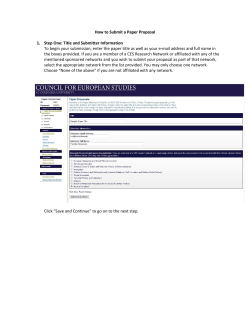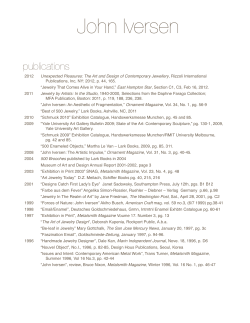
MICROSYMPOSIA
MICROSYMPOSIA acid residues and Fru-6P bound in the active site and in the Fru-2,6-P2 effecttor site We have examined the consequesces on the enzyme structure and function of the two gene-duplication events that occured in the yeast gene compared to the prokatyotic gene. Keywords: allostery, metabolism, regulation and reaction mechanisms of enzymes MS50.27.5 Acta Cryst. (2005). A61, C67 Molecular Basis for MSD and Catalytic Mechanism of the Human Formylglycine Generating Enzyme Markus Georg Rudolpha, Thomas Dierksb, Achim Dickmannsa, Bernhard Schmidtb, Kurt von Figurab, Ralf Ficnera, aDepartment of Molecular Structural Biology. bDepartment of Biochemistry II, University of Göttingen, D-37077 Göttingen, Germany. E-mail: mrudolp2@gwdg.de Sulfatases are enzymes essential for degradation and remodeling of sulfate esters. Formylglycine (FGly), the key catalytic residue in the active site, is unique to sulfatases. In higher eukaryotes, FGly is generated from a cysteine precursor by the FGly generating enzyme (FGE). Inactivity of FGE results in multiple sulfatase deficiency (MSD), a fatal autosomal recessive syndrome. We determined the FGE crystal structure by Ca2+/Sulphur SAD phasing using in-house data collected at a wavelength of 1.54Å. Based on this structure, we report that FGE is a single-domain monomer with a surprising paucity of secondary structure and adopts a unique fold. The effect of all eighteen missense mutations found in MSD patients is explained by the FGE structure, providing a molecular basis of MSD. The catalytic mechanism of FGly generation was elucidated by six high-resolution structures of FGE in different redox environments. The structures allow formulation of a novel oxygenase mechanism whereby FGE utilizes molecular oxygen to generate FGly via a cysteine sulfenic acid intermediate [1]. [1] Dierks T., Dickmanns A., Preusser-Kunze A. Schmidt B., Mariappan M., von Figura K., Ficner R., Rudolph M.G., Cell, 2005, 121, in press. Keywords: enzyme catalytic modification, genetic disease mechanism, post-translational MS51 COMPLEMENTARY APPROACHES TO BIOLOGICAL STRUCTURE DETERMINATION Chairpersons: Wah Chiu, Lucia Banci MS51.27.1 Acta Cryst. (2005). A61, C67 Estimating Protein Fold using Wide-angle Solution Scattering Data R.F. Fischettib, Lee Makowskia, D. J. Rodia , aBiosciences Division. b GM/CA-CAT, Argonne National Laboratory, 9700 South Cass Avenue, Argonne, IL 60439 . E-mail: lmakowski@anl.gov The secondary and tertiary structure motifs of protein folds have characteristic distributions of inter-atomic distances that produce features buried within the x-ray scattering pattern from a protein in solution. We have demonstrated that wide-angle x-ray solution (WAXS) scattering contains rich details of the secondary, tertiary and quaternary structure of multiple classes of proteins. Uses to date include the observation of ligand-induced structural changes and the monitoring of fold stages during chemical and radiation-induced protein denaturation. WAXS scattering patterns obtained at high flux third generation synchrotron beam lines are not only sensitive to protein conformation states, but the scattering patterns generated can be quantitatively compared to data calculated from detailed structural models derived from crystallographic data. This method can be applied to almost any protein in solution including membrane proteins, large protein complexes and proteins with substantially disordered regions. As such, WAXS has the potential for being a sensitive, global method for detecting ligand-induced structural changes in proteins, narrowly categorizing proteins based on their scattering homology to known folds and elucidating the differences between crystal structures and aqueous conformations. Keywords: protein structure analysis, WAXS, macromolecular structures MS51.27.2 Acta Cryst. (2005). A61, C67 Cryo-electron Microscopy of the Ribosome: Methods of Fitting, and Inference of Dynamics Joachim Franka, Haixiao Gaoa, Wen Lib, Jayati Senguptaa, aHHMI, HRI. bWadsworth Center, Empire State Plaza, Albany, New York. Email: joachim@wadsworth.org Cryo-electron microscopy yields “three-dimensional snapshots” of the ribosome and its interaction with ligands at time points determined by the use of antibiotics or GTP analogs. If several such snapshots are available for one of the functional processes, how can we obtain a seamless picture of its dynamics? We address the two aspects of this problem: the interpretation of medium-resolution cryo-EM density in terms of published coordinates of structural components, and the means of “interpolating” between subsequent structures inferred from the snapshots. This problem is exemplified by the investigation of the decoding process, for which four 3D snapshots are available [1,2]. [1] Valle M. et al., Nat. Struct. Biol., 2003, 10, 899. [2] Frank J., Sengupta J., Gao H., Li W., Valle M., Zavialov A., Ehrenberg M., FEBS Lett., 2005, 579, 959. Keywords: real-space refinement, MD simulation, decoding MS51.27.3 Acta Cryst. (2005). A61, C67 Structure of the Acrosomal Bundle, a Biological Machine, at 9.5 Å Resolution Michael F. Schmida, Michael B. Shermanb, Paul Matsudairac, Wah Chiua, aDepartment of Biochemistry and NCMI, Baylor College of Medicine, Houston, TX. bDept of Neurosciences, UTMB, Galveston, TX. cDept of Biological Eng. and Whitehead Inst, MIT, Cambridge, MA. E-mail: mschmid@bcm.tmc.edu In the unactivated Limulus sperm, a 60 µm-long bundle of actin filaments crosslinked by scruin is bent and twisted into a coil around the base of the nucleus. At fertilization the bundle uncoils and fully extends in five seconds to support a finger of membrane, the acrosomal process. This biological spring is powered by stored elastic energy and does not require the action of motor proteins or actin polymerization. Our 9.5 Å electron cryomicroscopic structure of the extended bundle [1] shows that twist, tilt, and rotation of actin-scruin subunits deviate widely from a "standard" F-actin filament. This deviation appears to be related to the packing requirements of the scruin cross-linkers. The structural organization allows filaments to pack into a highly ordered and rigid bundle in the extended state, but also suggests a mechanism for storing and releasing energy between the coiled and extended states. [1] Schmid M.F., Sherman M.B., Matsudaira P., Chiu W., Nature, 2004, 431, 104. Keywords: actin, electron microscopy, crystallography protein structures macromolecular MS51.27.4 Acta Cryst. (2005). A61, C67-C68 Beyond the Structure: how to Deal with Structural Disorder Claudio Luchinat, Magnetic Resonance Center , CERM , University of Florence, Italy. E-mail: luchinat@cerm.unifi.it Structural disorder in proteins is probably as precious as a source of information as the structure itself. In fact, disorder implies mobility. If we are able to translate what is observed as disorder, both in X-ray and NMR structures, into dynamics, we are in a better position to understand function. NMR is a powerful tool to analyse mobility in terms of time scales of motions, from seconds down to picoseconds. Novel approaches on how to deal with disorder by NMR will be shown, with particular reference to metalloproteins. Examples will range from the study of conformational flexibility at the active site of C67 MICROSYMPOSIA pharmaceutical targets [1] to multiple metal binding stoichiometries [2], from the assessment of relative interdomain motions in multidomain proteins [3] to the elucidation of the structure of a protein-protein complex where one partner is largely unstructured [4]. [1] Bertini I., Calderone V., Fragai M., Lee Y.-M., Luchinat C., Mangani S., Turano, Proc. Natl. Acad. Sci., in press. [2] Calderone V., Dolderer B., Hartmann H.J., Echner H., Luchinat C., Del Bianco C., Mangani S., Weser U., Proc. Natl. Acad. Sci., 2005, 102, 51. [3] Bertini I., Del Bianco C., Gelis I., Katsaros N., Luchinat C., Parigi G., Peana M., Provenzani A., Zoroddu M.A., Proc. Natl. Acad. Sci., 2004, 101, 6841. [4] Bertini I., Del Bianco C., Gupta Y., Luchinat C., Parigi G., Peana M., Zoroddu M.A., in preparation. Keywords: NMR, protein structures, dynamics MS51.27.5 Acta Cryst. (2005). A61, C68 The Organization of the Organic Structural Framework in the Enamel Biomineralization Processes Giuseppe Falinia, S. Fermania, C. Dub, J. MoradianOldakb,aDepartment of Chemistry "G. Ciamician", University of Bologna. bUniversity of South California, Los Angeles, CA, USA. Email: giuseppe.falini@unibo.it The growth of crystals within a preformed organic structural framework (the organic matrix) is a basic mode of skeletal formation adopted by many different organisms. Protein self-assembly into ordered structures is a critical step towards the control of mineral deposition in biomineralizing systems such as bone, teeth and mollusc shells.[1] Mammalian tooth enamel is the hardest tissue in the vertebrate body and is a secretory product of cells of epithelial origin called ameloblasts. Enamel mineralization is a dynamic process that includes protein secretion, matrix assembly and initiation and growth of the crystals within an amelogenin-rich matrix. The assembly of the mineralized enamel matrix continues through the transition stage during which ameloblast activity is drastically reduced and the bulk of the protein matrix is eventually processed during the maturation stage, concomitant with the rapid growth and maturation of the mineral. Supra-molecular self-assembly of the dental enamel protein amelogenin into nanospheres has been recognized to be a key factor in controlling the oriented and elongated growth of carbonated apatite crystals during dental enamel biomineralization. We report the formation of birefringent micro-ribbon structures that were generated through the supramolecular assembly of amelogenin nanospheres. These micro-ribbons have diffraction patterns that clearly indicate a periodic structure of crystalline units along the long axis. Linear arrays of nanospheres were observed as intermediate states prior to the micro-ribbon formation. The induction and c-axial orientated organization of apatite crystals parallel to the long axes of the micro ribbons were observed.[2] [1] Falini G., Fermani S., Roveri N., Current Topics in Crystal Growth Research, 2005, in press. [2] Du C., Falini G., Fermani S., Abbott C., Moradian-Oldak J., Science, 2005, in press. Keywords: biomineralization, enamel, fiber diffraction MS52 INORGANIC-ORGANIC FRAMEWORK MATERIALS Chairpersons: Christoph Janiak, Stuart R. Batten MS52.27.1 Acta Cryst. (2005). A61, C68 High Connectivity Framework Polymers: A New Co-ordination Chemistry Martin Schröder, School of Chemistry, University of Nottingham, Nottingham, NG7 2RD, UK. E-mail: M.Schroder@nottingham.ac.uk The concept of a co-ordination number and its relationship to specific co-ordination geometries describing the number and relative dispositions of ligands bound to a metal cation within a metal complex is very well established. In contrast, understanding which specific topology is associated with a particular connectivity of a metal ion within a framework polymer is less well developed, particularly for highly-connected nets. For example, 2-connected systems are commonly associated with linear or zig-zag chains, 3-connected with ladder, brick-wall or herringbone motifs, 4-connected with (4,4) square or adamantoid cages, and 6-connected with cubic or alphapolonium nets. Higher order frameworks of 5-, 7- and 8-connectivity are exceedingly rare, and we have developed, for the first time, a general route to such systems via the use of lanthanide nodes and Noxide bridging ligands [1]. The use of N-oxide ligands as linkers in such systems is based upon the complementarity of hard lanthanide ions, showing relatively high co-ordination numbers, with hard Odonors. Furthermore, N-oxides do not impose severe steric constraints on binding up to eight such ligands to a lanthanide centre. [1] Hill R.J., Long D-L., Champness N.R., Hubberstey P., Schröder M., Acc. Chem.. Res., 2005, in press and references therein. Keywords: coordination chemistry, lanthanide, topology MS52.27.2 Acta Cryst. (2005). A61, C68 Crystals and Nanostructures: a Unique Class of Tunable Inorganic-Organic Frameworks Jing Li, Xiaoying Huang, Department of Chemistry and Chemical Biology, Rutgers University, Piscataway, NJ 08854, USA. E-mail: jingli@rutchem.rutgers.edu An exciting and promising area of materials research that concerns chemistry and physics of inorganic-organic hybrid materials is rapidly emerging. Hybrid materials that combine the superior electronic, magnetic, optical properties and thermal stability of inorganic frameworks with the structural diversity, flexibility, high processability, and light-weight of organic molecules may reveal new phenomena and new properties, and enhance/strengthen the existing functionality and performance. Thus, they are of both fundamental and technological importance. We have recently developed a unique class of crystalline hybrid nanostructured materials with systematically tunable structures and multifunctional properties. The framework structures of these materials are composed of, at our choice, II-VI semiconductor nanometer sized motifs (inorganic component) and suitable organic spacers (organic component). They possess numerous improved properties over conventional II-VI semiconductor bulk materials, including broad band-gap tunability, high absorption coefficients, and large carrier diffusion lengths, all highly desirable for optoelectronic applications such as photovoltaics and solid state lighting. More significantly, they exhibit extremely strong quantum size effect and their nano properties can be systematically tuned by changing the structure and dimensionality of the inorganic motifs. Keywords: inorganic-organic hybrid material, II-VI semiconductor, nanostructure MS52.27.3 Acta Cryst. (2005). A61, C68-C69 New Molecular Architectures of Copper Imidazolates and Triazolates Xiao-Ming Chen, Jie-Peng Zhang, Xiao-Chun Huang, Department of Chemistry and Chemical Engineering, Sun Yat-Sen University, Guangzhou, China. E-mail: cescxm@zsu.edu.cn We recently exploited simple exo-bidentate and exo-tridentate ligands such as imidazolates and triazolates to generate a number of copper coordination polymers. Copper(I) cations can be conveniently generated from the hydrothermal treatments of copper(II) salts with organic ligands. A metal valence tuning approach with pH and temperature control has been utilized to generate a series of new mixed-valence CuI/CuII imidazolate polymers exhibiting different CuI/CuII ratios and topologic structures. More interestingly, using appropriate organic templates, we could also isolate a series of molecular polygons, namely octagons [Cu8(mim)8] and decagons [Cu10(mim)10]. We also found that 1,2,4-triazolates can also be prepared by hydrothermal treatments of organonitriles and ammonia in the presence of copper(II) salts. Two new 3-connected 3D networks Cu(mtz) and Cu(ptz) exhibit novel 4.8.16 and 4.122 nets. A predesigned metal-organic building block Cu(2-pytz) offers unusual supramolecular isomers upon variations of the reaction condition. C68
© Copyright 2025




















